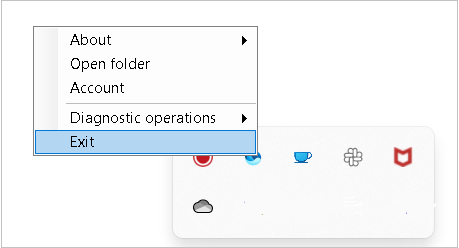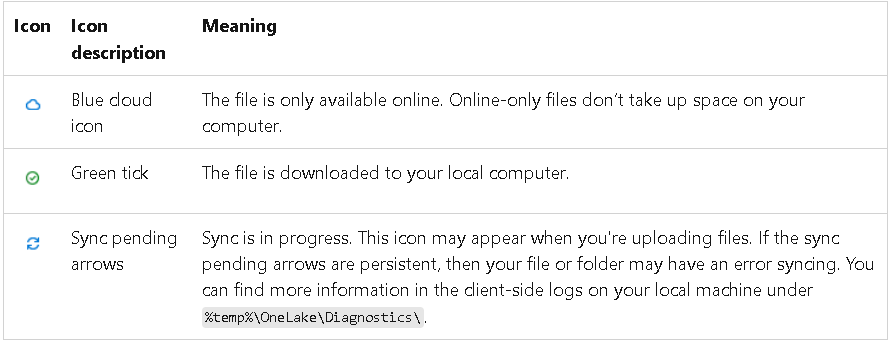This blog will guide you on how OneLake File Explorer works smoothly with Windows File Explorer. It makes syncing files easy, using smart placeholders. Your Windows interface becomes a powerful tool for collaboration.
OneLake file explorer
OneLake File Explorer is an application that seamlessly integrates OneLake with Windows File Explorer. It automatically syncs all OneLake items accessible through Windows File Explorer. The term “Sync” refers to updating metadata on files and folders, sending local changes to the OneLake service. Notably, syncing creates placeholders without downloading data, and the actual data is fetched by double-clicking on a file.
Note: OneLake file explorer still in preview
Key features of OneLake file explorer
Seamless Data Access
Enables users to access and manage their data in OneLake through the familiar Windows File Explorer interface.
Automatic Metadata Sync
Automatically syncs the metadata of files and folders with OneLake, ensuring that the information is up-to-date and consistent.
Data Download and Upload
Allows users to download or upload data to and from OneLake as needed, providing flexibility in managing their files.
File and Folder Operations
Supports common file operations such as creating, updating, or deleting files and folders directly within OneLake Explorer.
Real-time Reflection of Changes
Any changes made using OneLake Explorer, including file and folder operations, are reflected in OneLake in real-time.
Compatibility
Supports Windows 10 and 11, ensuring compatibility with the latest Windows operating systems.
How to Install
- Download OneLake file explorer
- Initiate the installation process by double-clicking the file.
After installing and launching the application, you can now view your OneLake data in Windows File Explorer as shown below

Initiate OneLake file explorer
To initiate OneLake File Explorer, you can follow these steps
- Automatic Startup
- OneLake File Explorer is designed to start automatically when your Windows operating system boots up.
- Manual Start
- Alternatively, you can manually start the application by searching for “OneLake” using the Windows Search feature (press Windows key + S) and selecting the OneLake application from the search results.
If you have disabled automatic startup, you might need to manually launch the application using the second method mentioned above.
Synchronize OneLake file explorer.
To synchronize updates in OneLake File Explorer, you can follow these steps.
- Automatic Sync
- OneLake File Explorer automatically syncs updates when you’re online and the application is running.
- The views for any folders that were previously synced refresh automatically when the application starts.
- Manual Sync
If you make changes to your files or folders outside of OneLake File Explorer and want to pull those updates, follow these steps.
- Right-click on the corresponding workspace, item, folder, or file in OneLake File Explorer.
- Select “Sync from OneLake” from the context menu.
- To pull updates for all workspaces, you can right-click on the OneLake root folder and select “Sync from OneLake.”
This manual sync action refreshes the view for any folders that were previously synced, ensuring that you have the latest updates from OneLake.
Handling multiple accounts
- During the installation of OneLake File Explorer, you can choose the specific account you want to sign in with.
- To switch accounts, right-click the OneLake icon in the Windows notification area, select Account, and then Sign Out. Signing out exits the explorer and pauses sync.
- Signing in with another account refreshes the list of workspaces and items. Workspaces associated with the previous account can be manually refreshed by selecting Sync from OneLake.
Access Fabric portal via OneLake file explorer
- In version 1.0.10.0, you can easily switch between OneLake File Explorer and the Fabric web portal.
- Right-click on a workspace and choose ‘OneLake->View Workspace Online’ to open the workspace in the Fabric web portal.
- Right-click on an item, subfolder, or file and select ‘OneLake->View Item Online’ to access the corresponding content on the Fabric web portal.”
Accessing OneLake File Explorer Offline
- Syncs occur only when online and the app is active.
- On startup, previously synced folders refresh automatically.
- Offline additions or updates display as sync pending until saved.
- Deleted files are recreated during refresh if they still exist on the service.
Exit OneLake file explorer
To exit OneLake File Explorer, follow these steps.
- Locate the OneLake icon in the Windows notification area, usually found at the far right of the taskbar.
- Right-click on the OneLake icon.
- From the context menu that appears, select “Exit”.

Closing the OneLake File Explorer application will pause the synchronization process, and access to placeholder files and folders may be limited.
File and Folder Management in OneLake file explorer
Creation process – You can create files or folders in OneLake by navigating through Windows File Explorer.
Deletion Process -You can easily delete files or folders within the OneLake section of Windows File Explorer.
File Editing – Open files with preferred apps, make edits, and save changes for seamless syncing.
- When you edit a file and hit Save, OneLake File Explorer checks if the file was updated elsewhere since your last sync. A Confirmation dialog box appears.
- Select “Yes”: Your local changes will overwrite any modifications made to the file since your last OneLake sync.
- Select “No”: Local changes won’t be transmitted to the OneLake service.
Copying and Moving – Use standard shortcuts or drag-and-drop functionality to copy or move files within and between items.
Performance and Support- Experience efficient performance, even with large files, and manage a significant number of files using OneLake File Explorer.
OneLake Shortcut Management- Easily view, update, and delete files and folders within OneLake shortcuts
OneLake File Explorer Icons and Their Meanings

Source: Microsoft learn
| Tags | Microsoft Fabric |
| Useful links | |
| MS Learn Modules | |
Test Your Knowledge |
Quiz |
